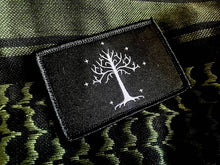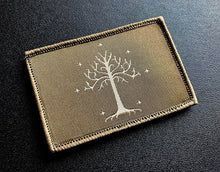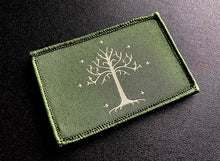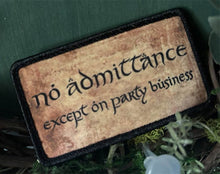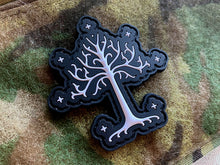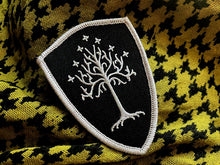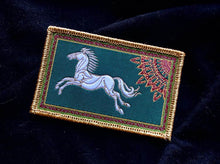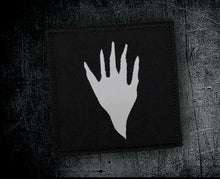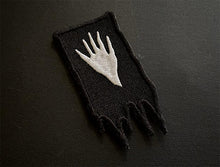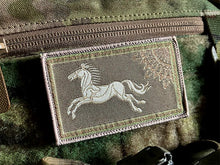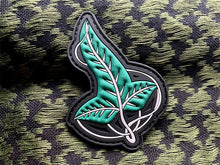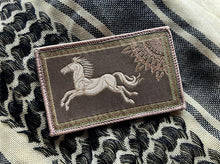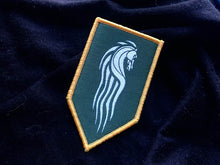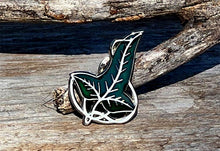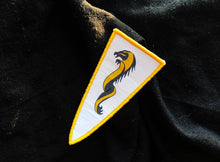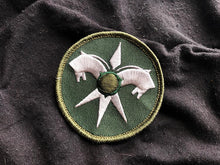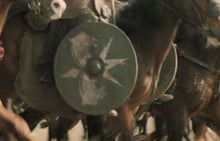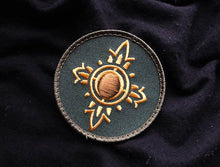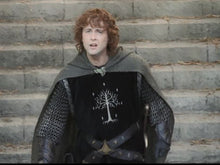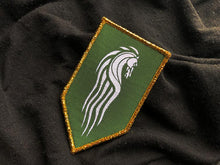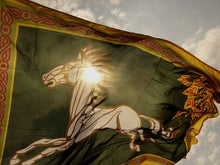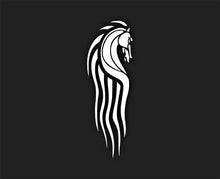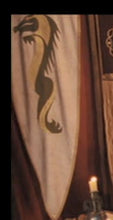Middle Earth
Texas 144.1
Regular price
$14.00
Sale
Middle-earth is the fictional setting of much of the English writer J. R. R. Tolkien's legendarium. The term is equivalent to the term Miðgarðr of Norse mythology and Middangeard in Old English works including Beowulf, describing the human-inhabited world, that is, the central continent of the Earth in Tolkien's imagined mythological past. Tolkien's most widely read works, The Hobbit and The Lord of the Rings, are set entirely in Middle-earth; "Middle-earth" has also become a short-hand for the legendarium and Tolkien's fictional take on the world.
Middle-earth is the main continent of Earth (Arda) in an imaginary period of the Earth's past with the end of the Third Age about 6,000 years ago. Tolkien's Middle-earth stories mostly focus on the north-west of the continent. This part of Middle-earth is suggestive of Europe, the north-west of the Old World, with the environs of the Shire intended to be reminiscent of England (more specifically, the West Midlands, with the town at its centre, Hobbiton, at the same latitude as Oxford).
Tolkien's Middle-earth is peopled not only by Men, but by Elves, Dwarves, Ents, and Hobbits, and by monsters including Dragons, Trolls, and Orcs. Through the imagined history, the peoples other than Men dwindle, leave, or fade, until after the period described in the books, only Men are left on the planet. - Wikipedia
-------------
I've always been fascinated by the imagination of Tolkien and took quickly to the Lord of the Rings series in the early 2000's. At the time I didn't realize how material rich those movies were. I sat down a few months ago and watched the entire series again taking note of all the symbols and flags. With that in mind, We're offering collectable patches based on imagery in the movie and when needed other interpretations.
Release 1 - Kingdom of Rohan
“And so the red blood blushing their faces and their eyes shining with wonder, Frodo and Sam went forward and saw that amidst the clamorous host were set three high-seats built of green turves. Behind the seat on the right floated, white on green, a great horse running free...”
- The Return of the King - The Field of Cormallen
Since before the days of Eorl the Young, the people of Rohan held great love for their horses. It was the horse that allowed them to come to the aid of Gondor on the fields of Celebrant, the horse that allowed them to patrol their kingdom with their Éored, and it was the horse that allowed them to cover the leagues between Dunharrow and Minas Tirith and arrive to do battle with the Armies of Mordor.
Throughout all this history, the flag of Rohan has remained mostly the same - a white horse upon a green field. In the film adaptations of The Lord of the Rings this flag can be seen multiple times; blowing in the wind at Edoras, and being carried into battle during the Ride of the Rohirrim. The flag shows a horse at its most free, galloping in a field of grass. It is my belief that this is the very aspect the people of Rohan strive for - to be free and merry, to sing their songs and ride their horses through their fair country.
The design of this patch follows the design of the flag seen in both The Two Towers outside Meduseld and in The Return of the King during the Battle of Pelennor Fields. While intricate in design, the flag itself is quite simple - a white horse running free in fields of green. Though not mentioned in the writings of Tolkien, a sun was added to the flag in the films. The addition of the sun seems fitting, as the sun is another motif Tolkien used as heraldry for Rohan throughout the story.
- 3.125x2"
- Woven
- Hook Backing
- Release: 04/02/2021
Release 2 - Kingdom of Gondor (variant 1)
"He had a small hauberk, its rings forged of steel, maybe, yet black as her; and a high-crowned helm with small raven-wings on either side, set with a silver star in the centre of the circlet. Above the mail was a short surcoat of black, but broidered in the breast in silver with the token of the Tree."
Perhaps one of the most widely recognized symbols from The Lord of the Rings trilogy is the White Tree of Gondor. The Tree is used in many different sigils, ranging from the guards of the Tree itself to the flags and banners of Minas Tirith to the livery given to the Hobbit Peregrin Took after he swore fealty to Denethor, Steward of Gondor.
Pippin continued to wear the symbol of the Tree on his armor even after returning to the Shire, where he became the thirty-second Thain after the days of the War of the Ring. Eventually he renounced the position and returned with his good friend Meriadoc Brandybuck to Gondor, where he was eventually laid to rest and entombed with King Elessar.
The design of the Kingdom of Gondor patch is based on the livery Pippin wore in The Return of the King, showing the White Tree and seven stars upon a black background. Pippin is seen wearing this during his service to Denethor and then later, outside the Black Gates. There are other variations of the White Tree in both the films and in Tolkien’s work, including the standard of Aragorn that was unfurled as he sailed to Gondor’s aid during the Battle of Pelennor Fields.
- 3x2"
- Woven
- Hook Backing
- Release: 04/12/2021
Release 3 - Kingdom of Rohan (Rohirrim)
This symbol is visible behind the throne in a meeting hall. It represents the horse riders of Rohan. The banner itself is longer and more narrow with some ornate design on the bottom. We simplified it for the purposes of the initial patch design.
- 2x3.45"
- Woven
- Hook Backing
- Metallic/Non-Metallic Options
- Release: 04/28/2021
- Vinyl Decal measures 6" high
Release 4 - Pelennor Shield
“Arise, arise, Riders of Théoden!
Fell deeds awake: fire and slaughter!
spears shall be shaken, shield be splintered,
a sword-day, a red day, ere the sun rises!
Ride now, ride now! Ride to Gondor!”
- The Return of the King - Chapter V - The Ride of the Rohirrim
Eorl the Young was given parts of Calenardhon by Cirion, Steward of Gondor, after leading his people to Gondor’s aid in the fields of Celebrant. It was here that the army of Gondor were cut off from the south and laid upon by a host of Orcs and driven toward the Anduin. The Riders of Eorl then set upon the Orcs from the rear, and slaughtered them. After this a great friendship began between the kingdoms of Gondor and Rohan, and an oath was made that each other would help their allies in times of war.
Shortly after defeating Saruman’s Uruk-Hai at Helm’s Deep, Théoden son of Thengel mustered his Rohirrim at Dunharrow, where an errand-rider of Gondor presented him with the Red Arrow. Denethor, Steward of Gondor, asked Théoden to bring his Rohirrim with all their strength and all their speed to prevent the White City from falling. The Riders of Théoden were mustered and rode to Gondor, where they fell upon the Orcs of Mordor from the rear, helping to save the city. Here Théoden was slain by the Witch-King, and Eomer his sister-son inherited the throne.
This design is based on a shield seen during the Battle of Pelennor Fields in The Return of the King, when the Rohirrim charged against the armies of Mordor. It is notable for being the only shield with two horses on it, which could mean it belonged to a rider who served under or with Théodred, the son of Théoden, who was the Second Marshall of the Mark. It is possible the two horses reference the Second Marshall of the Mark, but there is no proof of this. It is, perhaps, a conjecture - but it is one based on hope
- 2.5" round
- Twill/Embroidered
- Hook Backing
- Release: 05/21/2021
Release 4b - Edoras Shield P1 (Blem)
** Blem - The 3D center did NOT come out the way in production as our initial prototypes did so the 'center' is not a perfect circle. **
“Up the green terrace went a stair of stone, high and broad, and on either side of the topmost step were stone-hewn seats. There sat other guards, with drawn swords laid upon their knees. Their golden hairs was braided on their shoulders; the sun was blazoned upon their green shields, their long corslets were burnished bright, and when they rose taller they seemed than mortal men.” - The Two Towers - Chapter VI - The King of the Golden Hall
The guard of Théoden son of Thengel stood apart from other men of Rohan, tall and strong and ready to do battle for their king. Of their number, Háma was their captain and a doorward at Meduseld while Théoden was under the spell of Saruman. Though loyal to his king, Háma allowed the wizard Gandalf to bring his staff into the Golden Hall subsequently leading to Théoden regaining his youth and leading Rohan to victory at Helm’s Deep. It was here that Háma fell in battle, defending the gate of the Hornburg; and it was here that Háma was buried, given a grave apart from the mounds honoring the men of the East Dales and those of the Westfold, alone under the shadow of the fortress would he forever rest.
The design of this patch is based upon the shield of portrayal of the doorward of Théoden as seen in The Two Towers at Edoras. A similar symbol can be seen above the doors of Meduseld, and the design is reflected in much of the imagery seen in Rohan. The somewhat abstract style of art used in the films is represented here, where we see a depiction of the sun on the shields of the royal guard.
- 2.5" round
- Twill/Embroidered
- Hook Backing
- Release: 05/21/2021 (P1 Blem)
Release 5 - Éothéod
“Frumgar, they say, was the name of the chieftain who led his people to Éothéod. Of his son, Fram, they tell that he slew Scatha, the great dragon of Ered Mithrin, and the land had peace from the long-worms afterward.” - Appendix A, II The House of Eorl
Long before Eorl was bequeathed Calenardhon by Cirion, Steward of Gondor, the ancestors of the Rohirrim lived in the North, between the Misty Mountains and the northernmost parts of Mirkwood. The only recorded instance of an ancestor of Théoden having faced a dragon is Fram, son of Frumgar who slew Scatha in a time before Eorl the Young settled his people in Rohan.
This design is based on a banner seen hanging in the Golden Hall; a design that is similar to the engravings on the pillars outside of Meduseld, in their capital of Edoras. The banners hanging in the hall of Meduseld were covered in figures of ancient legend for Rohan and with the knowledge that Fram slew Scatha, the last of the long-worms in Ered Mithrin, it is assumed that this design hearkens back to Fram son of Frumgar, chieftain of the Éothéod.
- 1.75x4"
- Woven
- Hook backing
- Release: 6/2021
Release 6 - Leaves of Lorien
"The Elves next unwrapped and gave to each of the Company the clothes they had brought. For each they had provided a hood and cloak, made according to his size, of the light but warm silken stuff that the Galadhrim wove. It was hard to say of what colour they were: grey with the hue of twilight under the trees they seemed to be; and yet if they were moved, or set in another light, they were green as shadowed leaves, or brown as fallow fields by night, dusk-silver as water under the stars. Each cloak was fastened about the neck with a brooch like a green leaf veined with silver."
The Fellowship of the Ring - Farewell to Lorien
Lothlórien was the home of the Galadhrim, and was known to be the fairest of all elven realms in Middle Earth. In Lothlórien are found the only golden Mallorn trees, which were in part made possible by Nenya, one of the Elvish Rings of Power, as it was wielded by Galadriel.
The leaves of Lothlórien were said to not fall, but instead would turn to gold in the Autumn, and only fall come the springtime when the new leaves sprout. The floor of the forest is littered with golden leaves, and the bark of the trees is grey and smooth to the touch, unlike any other tree in Middle Earth.
But the forest would not always be this way - after the defeat of Sauron by the destruction of the One Ring, Galadriel sailed to the West, taking with her Nenya and thus the magic that had made Lothlórien the fair realm that it was began to fade. It is said that the remaining Galadhrim departed and the trees no longer turned gold. It was here, in what had once been beautiful woods, that Arwen laid herself to rest after the death of Aragorn after his long reign as King of Gondor. Having accepted the Doom of Men, Arwen's grave would lie in the woods of Lothlórien long after her memory faded from the minds of men.
This patch bears resemblance to the brooches given to the Fellowship by Galadriel after the fall of Gandalf the Grey. All eight members received a brooch, though in a moment of foresight and intelligence the Hobbit Pippin dropped his brooch to the ground allowing Aragorn to find it and give the Three Hunters hope that he and Merry were still alive. The Elven Brooch is perhaps one of the most widely recognized symbols in the Lord of the Rings, after of course the One Ring and the White Tree, and this patch is one humble way to do it justice.
- PVC
- Hook Backing
- ~3x2"
- Release: 7/15/2021
- Refreshed for 2024 with a brighter silver
Release 7 - Kingdom of Rohan Banner 2022
- Theoretical
- Embroidered
- Hook Backing
- Release: 4/2/2022
Release 8 - Tree of Gondor PVC
- PVC
- Hook Backing
- Release: 3/2023
Release 9 - Kingdom of Gondor Shield
- Embroidered
- Hook Backing
- ~3.25x2.5
- Release: 9/16/23
- Vinyl Decal found here
Release 10 - Leaves or Lorien Enamel Pin
- 1.5" tall
- Clasp backing
- Release: 10/3/2023
Release 11 - The White Hand (Uruk Hai)
“After they had ridden for some miles, the highway became a wide street, paved with great flat stones, squared and laid with skill; no blade of grass was seen in any joint. Deep gutters, filled with trickling water, ran down on either side. Suddenly a tall pillar loomed up before them. It was black; and set upon it was a great stone, carved and painted in the likeness of a long White Hand. Its finger pointed north. Not far now they knew that the gates of Isengard must stand, and their hearts were heavy; but their eyes could not pierce the mists ahead.”
The Two Towers - The Road to Isengard
The White Hand was first seen prominently during the Third Age of Middle Earth, as a symbol adorning the banners and shields of the fighting Uruk-Hai of Isengard. The symbol was first recorded as being seen by the Three Hunters after the passing of Boromir, on the shields of four Uruk-Hai among the orcs the Man of Gondor had slain defending the hobbits Peregrin and Meriadoc.
The symbol was surely seen by those of the Rohirrim during their battles with the forces of Saruman, perhaps during the battle of the Fords of Isen where Théodred son of Théoden was slain, but most assuredly it would have been seen in the host that marched against Helm’s Deep and laid siege to the fortress. The Uruk-Hai helmets were also adorned with an S rune, which at first was thought to stand for Sauron - but the Dark Lord did not use elf-runes for his armies.
Saruman was one of the Istari, akin to Gandalf the Grey, who were sent to Middle Earth to help contest the power of Sauron and unite all those who would oppose him - but Saruman the White fell to the allure of power and slowly began to amass armies for himself in an attempt to challenge the Dark Lord and find the One Ring for his own purpose. His spies tracked the Fellowship during their journey, and he corrupted the King of Rohan to weaken his foes. Prior to unleashing his armies bearing the White Hand he revealed himself to Gandalf as Saruman the Many Colored and openly opposed his fellow Istari.
After the fall of Sauron it is not known if Saruman used the White Hand during his time known as Sharkey when he assumed control of the Shire through manipulation and violence, and it is not recorded in the Red Book as being seen by the four Hobbits during the Battle of Bywater and the rebuilding of the Shire, but it is widely acknowledged that the death of Saruman is considered the end of the War of the Ring.
The White Hand patch is an interpretation of the symbol Saruman used in the films during the Battle of Helm’s Deep, and can be seen on the banners of the Uruk Hai as they march into the valley and towards the Deepening Wall - a similar design is on the shields of some of the Uruks. The symbol on some of their helmets and even faces is far more reminiscent of an actual white handprint, and can be seen being applied by other Uruks during the Fellowship of the Ring.
- 3" tall / 2.5x2.5" for version II
- hook backing
- Release: 08/09/2024
Release 12 - No admittance except on party business
- 3.5x2"
- woven
- hook backing
- Release: 06/13/25

























